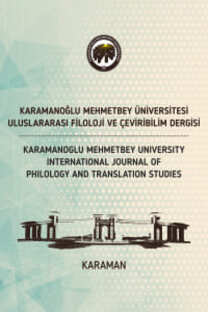JOHN LANCHESTER’IN THE WALL ROMANINDA İNSAN İSTİSNACILIĞI, KIRILGANLIK VE TEKDÜZEN EKONOMİSİ
John Lanchester’ın The Wall (2019) adlı romanı, aşırı yükselen deniz seviyeleri şeklinde tecelli eden iklim değişikliğinin, büyük kara parçalarının çoğunluğunun sular altında kalmasına ve milyonlarca insanın evlerini kaybetmesine sebebiyet vererek onların açık denizlerde hayat mücadelesi veren çevresel olarak yerinden edilmiş insanlara dönüştüğü bir distopik dünya sunmaktadır. Romanda, iklim değişikliğinden mucizevi bir şekilde sadece kısıtlı bir biçimde etkilenen Britanya, sadece suyu değil aynı zamanda çevresel olarak yerinden edilmiş insanları da dışarıda tutmak için on bin kilometre uzunluğunda tüm sınırlarını çevreleyen bir duvar inşa eder. Duvarın bu iki işlevi göz önüne alındığında, bu çalışma, bu duvar imgesini, ilk olarak, bu ölçekte bir iklim felaketinin dahi hala bir şekilde kolay başa çıkılabilir olduğu yanlış izlenimini veren insan istisnacılığının bir yansıması olarak tartışmayı hedeflemektedir. İkinci olarak ise, duvarın, içeridekiler (duvarın içerisinde olanlar) ve dışarıdakiler (duvarın dışında kalan çevresel olarak yerinden edilmiş insanlar) arasında aşılmaz bir bölünme yaratarak—ki bu bölünme sadece ikinci grubun güvencesizliğini azami seviyeye çıkarmakla kalmaz aynı zamanda onların yaşamlarını elden çıkarılabilir kılar—başkalarının kırılganlığını ve güvencesizliğini kasıtlı bir şekilde göz ardı eden ve artıran bir tekdüzen ekonomisinin sürdürülmesinde bir katalizör görevi gördüğünü tartışmaktadır.
Anahtar Kelimeler:
John Lanchester, The Wall, insan istisnacılığı, kırılganlık, güvencesizlik, tekdüzen ekonomisi
HUMAN EXCEPTIONALISM, PRECARIOUSNESS, AND ECONOMY OF SAMENESS IN JOHN LANCHESTER’S THE WALL
John Lanchester’s The Wall (2019) presents a dystopic world where climate change in the form of extreme rising sea levels has caused the majority of the landmasses to be inundated and millions of people to lose their homes, transforming them into environmentally displaced people who try to survive in the open seas. In the novel, miraculously affected by climate change only in a limited way, Britain builds a ten-thousand-kilometer-long wall that circumscribes all its borders to keep not only the water out but also the environmentally displaced others. Given this double function of the wall, this article aims to discuss this image of the wall, first, as a reflection of human exceptionalism which gives off the false impression that even a climate disaster at that scale is still somehow tractable. Second, it further argues that the wall acts as a catalyst for perpetuating an economy of sameness or self-identity that deliberately ignores and increases the vulnerability and precarity of others by creating an impassable divide between insiders (i.e. those inside the wall) and outsiders (i.e. the environmentally displaced people)—a divide that not only maximizes the precarity of the latter group but also casts their lives as disposable.
Keywords:
John Lanchester, The Wall, human exceptionalism, precariousness, precarity, economy of sameness,
___
- Agamben, Giorgio. (1998) Homo sacer: Sovereign power and bare life (D. Heller-Roazen, Trans.). Stanford: Stanford University Press. (Original work published 1995).
- Allardice, L. (2019, January 11). John Lanchester: “Walls were coming down around the world—now they are springing up.” The Guardian. Retrieved from https://www.theguardian.com/books/2019/jan/11/john-lanchester-interview-the-wall.
- Anguelovski, I., Connolly, J.J.T., Persall, H., Shokry, G., Checker, M., Maantay, J., … Timmons Roberts, J. PNAS 116 (52), 26139–26143.
- Butler, J. (2004). Precarious life: The powers of mourning and violence. New York: Verso.
- Butler J. (2009). Frames of war: When is life grievable? New York: Verso.
- Charlier, R. H., Chaineux, M. C. P., & Selim, M. (2005). Panorama of the history of coastal protection. Journal of Coastal Research, 21 (1), 79–111.
- Crutzen, P., and Stoermer, E. (2000). The ‘Anthropocene.’ IGBP Newsletter, 41, 17–18.
- EEA Report (European Environment Agency). (2006). The changing faces of Europe’s coastal areas (6). Retrieved from https://www.eea.europa.eu/publications/eea_report_2006_6.
- Fukuyama, F. 2002. Our posthuman future: Consequences of the biotechnology revolution. New York: Farrar, Straus and Giroux.
- Ganteau, J-M. (2015). The ethics and aesthetics of vulnerability in contemporary British fiction. New York: Routledge.
- Graham, E. (2002). Representations of the post/human: Monsters, aliens and others in popular culture. Manchester: Manchester University Press.
- Haraway, D. (2003). The companion species manifesto: Dogs, people, and significant otherness. Chicago: Prickly Paradigm Press.
- Haraway, D. (2008). When species meet. Minneapolis: University of Minnesota Press.
- Kashmir, S. (2018). Precarity. In The Cambridge encyclopedia of anthropology. Retrieved from https://www.anthroencyclopedia.com/entry/precarity.
- Lanchester, J. (2019). The Wall. London: Faber & Faber.
- Levinas, E. (1985). Ethics and infinity: Conversations with Philippe Nemo (R. A. Cohen, Trans.). Pittsburgh: Duquesne University Press. (Original work published 1982).
- Malone, N., & Ovenden, K. (2016). Natureculture. In A. Fuentes (Ed.), The international encyclopedia of primatology. Retrieved from https://onlinelibrary.wiley.com/doi/full/10.1002/9781119179313.wbprim0135.
- Park, C. (2012). Human exceptionalism paradigm. In A Dictionary of Environment and Conservation. Retrieved from https://www.oxfordreference.com/view/10.1093/oi/authority.20110803095949791.
- Ruti, M. (2017). The ethics of precarity: Judith Butler’s reluctant universalism. In M. van Bever Donker, R. Truscott, G. Minkley, & P. Lalu (Eds.), Remains of the social: Desiring the Post-apartheid (pp. 92–116). Johannesburg: Wits University Press.
- Standing, G. (2011). The precariat: The new dangerous class. London: Bloomsbury Academic.
- Thomas-Corr, J. (2019, January 15). The Wall by John Lanchester review—Dystopian fable for our time. The Guardian. Retrieved from https://www.theguardian.com/books/2019/jan/15/the-wall-by-john-lanchester-review
- Vij, R. (2019). The global subject of precarity. Globalizations, 16 (4), 1–19.
- Watson, J. (2012). Butler’s biopolitics: Precarious community. Theory & Event, 15 (2). Retrieved from https://www.muse.jhu.edu/article/478357.
- Yayın Aralığı: Yılda 2 Sayı
- Başlangıç: 2018
- Yayıncı: Karamanoğlu Mehmetbey Üniversitesi
Sayıdaki Diğer Makaleler
19. YÜZYIL İNGİLİZ SEYAHATNAMELERİNDE KIBRIS
YER ADLARININ ÇEVİRİSİNDE SİYASİ SORUNLAR
Araf SAİD, Çevirmen: Nesibe ERKALAN ÇAKIR
JEAN-MARIE GUSTAVE LE CLÉZIO ve KÜLTÜRLERARASILIK
Coleridge’ın Radikal Kişiliği ve Güney Batı Topluluğu
GÖNDERMELERİN İNGİLİZCEDEN TÜRKÇEYE ALTYAZI ÇEVİRİSİ: SHERLOCK DİZİSİ İNCELEMESİ
Emrah BOYNUKARA, Aslı Özlem TARAKCIOĞLU
ANTON ÇEHOV'UN “ACI” ADLI ÖYKÜSÜNE GÖSTERGEBİLİMSEL BİR BAKIŞ
ANTON ÇEHOV'UN “ACI” ADLI ÖYKÜSÜNE GÖSTERGEBİLİMSEL BİR BAKIŞ
ORTADOĞU’DAN ÇEVİRİ ARACILIĞIYLA AKTARILAN İSLAMCI GÖRÜŞLERİN TOPLUMSAL KÜLTÜRE ETKİSİ
Muharrem TOSUN, Iskender GUNES
JOHN LANCHESTER’IN THE WALL ROMANINDA İNSAN İSTİSNACILIĞI, KIRILGANLIK VE TEKDÜZEN EKONOMİSİ
